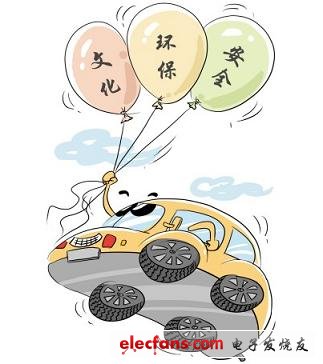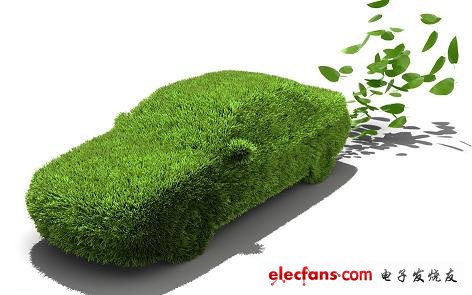Electronics enthusiast news: This article mainly talks about the design direction and latest solutions of China's new generation of automotive electronics with automotive semiconductor manufacturers. With the development of the times, the acceleration of life rhythm and the improvement of people's ideological realm, the design direction of China's new generation of automotive electronics will inevitably point to the two major weather vanes of "safety" and "environmental protection"!
At a time when the Chinese auto market is suffering from the impact of the economic crisis, the two major trends of improving car safety performance and environmental protection are also driving the development of a new generation of cars, and guiding car manufacturers to produce the most consistent and distinctive features that are in line with consumer intentions. Next generation car.
In order to reduce energy consumption and reduce greenhouse gas emissions, the application of green environmental protection in the design of automotive electronics is the general trend. In addition to using many traditional technologies to make cars more in line with environmental requirements, various alternative forms of automotive energy, whether it is alternative fuel (such as methanol, ethanol, etc.) vehicles, or hybrid (oil-electric combination) vehicles (HEV) or pure electric vehicles (EV), has become the top priority for automotive manufacturers to design projects.

Anticipation of the economy has made consumers' demand for new car features first oriented by safety. Advanced safety systems that can protect the safety of drivers, passengers, and pedestrians, and effectively reduce accidents, such as advanced driver assistance systems that do not require too much cost, will be a rapidly growing field of automotive electronics and have an important impact on the differentiated design of automobiles. In addition to passive safety systems such as airbags, more and more cars will use active vision-based safety systems in the future, including rear-view systems, lane departure warning systems, driver attention warning systems, headlight control systems, and collision prevention systems And an automatic cruise control system that can detect and distinguish objects under various lighting conditions.
Hybrid power consumption reduction
In the long run, a key trend in automotive design is to reduce energy consumption and gas emissions. From an energy-saving perspective, there are now different "green car" designs, some of which allow consumers to meet their needs with less budget. For example, the Start-stop function is an energy-saving function at a reasonable price. This function allows the internal combustion engine to automatically suspend operation when the car encounters a red light or is in a traffic jam. The additional cost of the entire start / stop function is only $ 300, but it can save 3% to 10% of fuel, and the effect is very significant. If the car is driving in a city with very heavy traffic, it can even save up to 25% of fuel.
Another situation is that the lighter the car, the less fuel is required. Today a typical car has up to 100 electronic control modules (such as ABS, ESP, automatic windows, rear seat entertainment system for children, etc.), all of which communicate with each other through copper wires. If you use FlexRay and similar technologies to run through a single bus system, completely abandon the copper wire, you can significantly reduce the weight of the car body. NXP's automotive network bus products (including CAN / LIN bus transceivers) have lower power consumption, better EMC and ESD performance, and are ideal solutions to meet the needs of such applications.
The use of alternative fuel vehicles and EV / HEV is an important part of the green design of automobiles. Compared with traditional cars, HEV's automotive power transmission system requires more electrical management systems, which brings new challenges to power management.

"For EV / HEV, the main design challenge is to maintain the battery energy density (kW-hr capacity per kilogram of packaged battery quality); then is how to design an efficient inverter and how to design an efficient DC / DC converter in order to Power supply for 12V load, and how to manufacture the above devices in a cheap way, and achieve the minimum weight and size. "Fairchild Semiconductor's senior manager of the automotive market RoyDavis said.
Gary Wagner, director of Fairchild ’s body electronics / smart switch business, further explained: “Specifically, the challenges in power technology include: reducing the cost of packaging silicon devices (or other semiconductors); reducing the footprint of the sealed power stage ; Reduce the loss of switching devices; improve heat dissipation performance and at the same time increase the operating temperature of silicon devices (or other semiconductors) and packages, and use newer switching technologies and power circuit topologies. "
Solving these design challenges requires lightweight packaging materials, innovative compact heat dissipation solutions, high-efficiency power switching devices and control technologies, and improved use of magnetic materials in inductors and transformers, making these devices smaller and lighter. Fairchild's modules and FANxxxx series devices, as well as any PWM controllers that can be converted to automotive applications to help reduce energy consumption, are used to solve these challenges.
Another key issue in HEV design is high voltage. "Since the light, comprehensive and plug-in HEV requires high-voltage electronic systems between 600V and 1,200V, this makes the design more challenging. It must be in the range of 10kW to more than 100kW according to the type, size and use of the car Drive the engine. HEV's high-voltage architecture also requires the deployment of additional peripheral systems and energy and battery management units. "Said Dr. Henning M. Hauenstein, Vice President and General Manager of Automotive Products of International Rectifier (hereinafter referred to as IR).
In addition, it is necessary to integrate the electric power system and other new electronic systems into the new HEV car architecture. The new electronic systems include DC / DC converters that can realize energy transmission between 12V and high-voltage power grids, and air conditioners , Power steering system and many other electronic drive systems. Dr. Hauenstein pointed out: "This is a big challenge, because in the past, automotive electronic systems were used to work in a 12V battery environment, but now we must face these threats to equipment and life safety brought by high-voltage electronics, we must take these Dangerous electronic systems are safely isolated. "
IR can provide a comprehensive chipset solution for almost all power management applications in a modern HEV, including high-voltage driver ICs, smart power ICs, smart switches, MOSFETs, and high-voltage IGBT switches for low, medium, and up to 1,200V . The company recently launched a DirectFET product line for bondless cars. This revolutionary new concept of MOSFET packaging not only brings very low RDS (ON) to the design of DC / DC converters and battery management systems, but also eliminates the bonding wires, making the parasitic inductance under fast switching conditions basically Up to zero.
Energy Efficient LED Desk Lamp that will reduce energy spending by 75%
Applications:
1. Reading, writing,drawing, design,computer operation,documentation in office, or home lights.2. Meeting, office welfare, opening ceremony, move, foreign affairs, wedding, celebration.
3. working, suitable light for eye-care
4,relax, warm white give you comfortable light sense
LED Table Lamp With Battery
LED Table Lamp With Battery,Portable Table Lamp With Battery,Portable LED Table Lamp,Battery Operated Table Lamps,LED Table Lamp
Shenzhen Superlight Technology Co., Ltd. , https://www.superlighttech.com